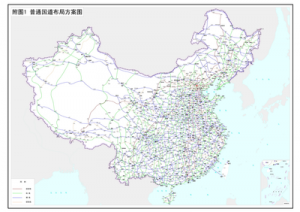China has a series of “trunk roads” that run all across the mainland connecting high populated cities to one another. Citizens oftentimes refer to these roads as highways, however they are not necessarily freeways due to their traffic control measures. 
There is an accepted speed limit on the highways of 100km/h, but rarely do drivers heed these limits as there is a lack of speed detection cameras and police officers enforcing the speed are few and far between.
The highways are named using a descriptive numbering system. Each highway name begins with the letter G and is followed by three numbers. The original 12 highway routes (5 vertical and 7 horizontal) are labelled using a 000 series. Highways in the 100 series all begin in Beijing and spread throughout the country in all directions. Highways in the 200 series travel from north to south, and 300 series highways from east to west. Finally, 500 series highways are roads that connect larger, national highways.
The rapid growth in highway construction across China has been noted as one of the key factors in accelerating infrastructure construction. In 2004, China’s highway length ranked second in the world with 1.871 million kilometers of highways open to traffic. More recently, in 2013 China’s Ministry of Transport announced the “National Highway Network Planning” program which will result in 119 total highways by the year 2030. It will be interesting to observe the effect the Ministry’s new program will have on infrastructure development across the country.
So are highways good for China’s interior? For its big cities? What are the implications for the geography of production?
A limit of 100km/hr is an administrative choice. Why and how should speed limits be imposed?
I can recast in economic jargon: what are the (positive, negative) externalities that accompany better roads?
Are the highways a good measure of economic growth? If so, will the expansion of highways into rural China aid in decreasing the rural-urban poverty disparity? Furthermore, what impacts have we/will we see on migration?
At the very least, highways provide a form of government spending, increasing China’s GDP. The creation of a road network creates jobs during the development period, but it also allows for transportation of goods. This, in turn, aids in the growth of commerce in previously unchartered areas.
The construction of highways is one major method of promoting development in the central and western provinces. One of the largest barriers that these provinces face is high transportation costs and unpredictable delivery schedules due to poor infrastructure. The construction of a national highway system will help to reduce transportation costs and result in increased investment in the inner provinces.
According to Peter Hessler’s Country Driving, Chinese truck drivers are among the “purest entrepreneurs in the country.” While traveling west into the Gansu Province, Hessler encountered a trucker named Li Changjie who left his farmland to do business and succeed in the evolving economy. With urban development at exit points, constructing national highways increases self-employment opportunity for rural migrants in the trucking industry as more routes become available.
When there are more highways, one thing that will appear is the expansion of cities. According to changes in bid rent curve in Urban Economics, the appearance of highways shortens the commute time for workers so they are willing to live further from the city centers. This moves the labor supply curve out so the business in the center of the city indirectly benefit from it by being able to pay less to workers. Therefore, the bid rent curve of business in the center of a city shifts out while the bid rent curve of workers shifts in, and the final conclusion is that everyone (business, residents, and agriculture) gets bigger areas to live with. In other words, the city expands. The increase of Chinese highways will eventually lead to all the big cities in China to expand even bigger. I wish I can draw these curves here but I don’t know how. I learned these in Prof. Shester’s Urban Economics.
Just as it happened in the US with the creation of interstate highways, China will continue to invest in infrastructure and it will increase the overall migration of people to cities, sprout new cities in the interior, and further integrate government control of the interior of China. It also is a means to increase government spending thus effecting GDP growth and if the highways are built in effective areas, shouldn’t it have a positive long term impact in the integration of rural and urban China?